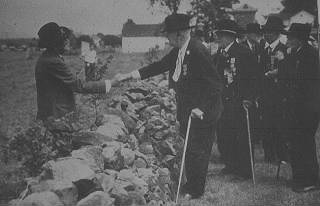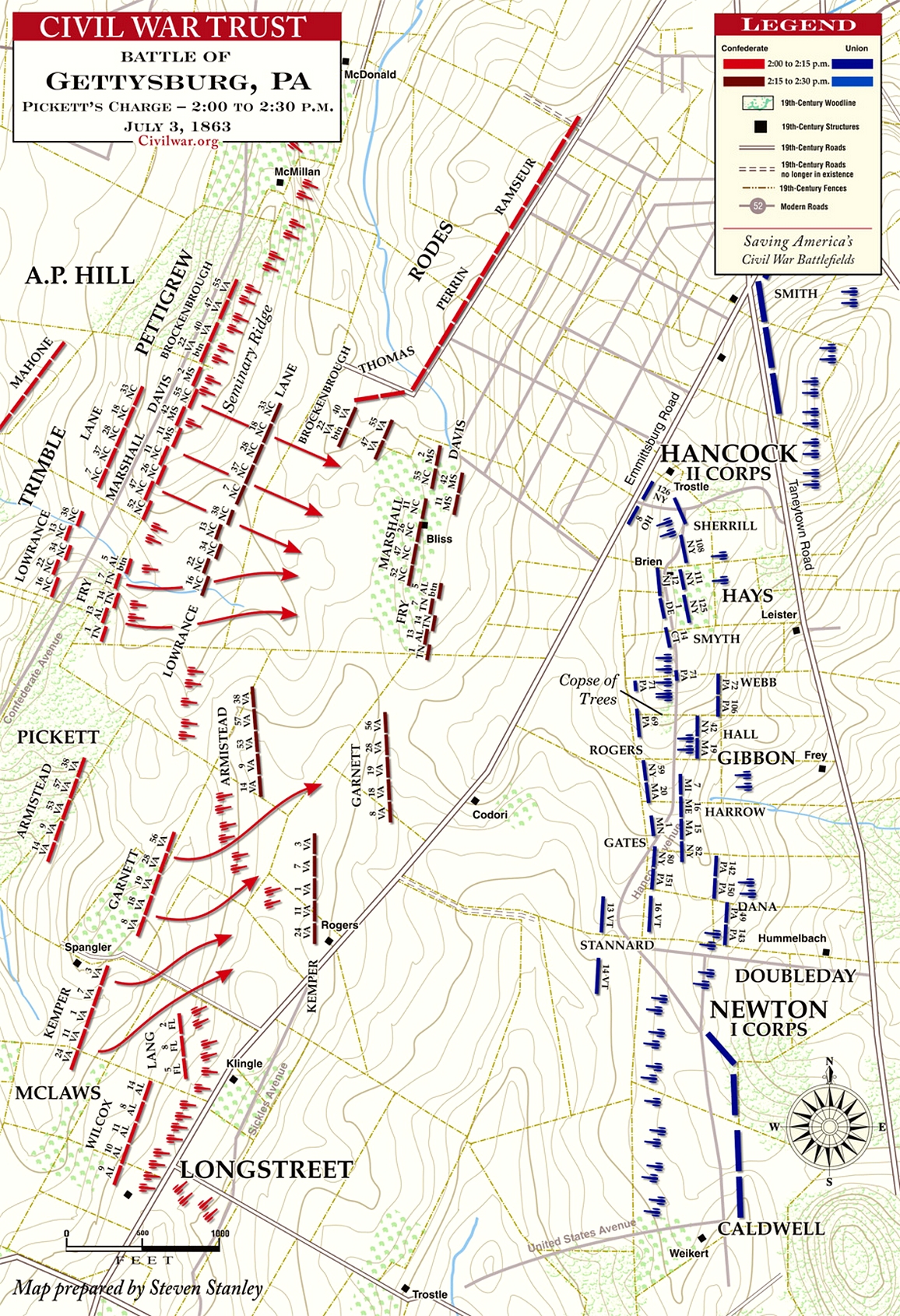|
75th Gettysburg Reunion
Last Battle of Gettysburg Reunion Photo, Photos of Confederate Union Battle of Gettysburg
Veterans Soldiers in 1938, Pickett’s Charge, Division, The Bloody Angle Cemetery Ridge, Seminary Ridge Picture
The Last Gettysburg Reunion
Battle of Gettysburg 75th Anniversary
Introduction
In 1938, seventy five years after the fight, at the last great
reunion of the Blue and the Gray at Gettysburg, a small group of veterans from Virginia and Pennsylvania met near the "Angle." As cameras rolled and clicked, the old gentlemen shook hands over the
stone wall where General Hays' Division stood on July 3, 1863. Though it is unknown whether
any of these veterans were actually present during the fighting at the Angle, this particular photograph was used to publicize
the event and illustrate the last meeting of the two associations that had met at the Angle up to 1913. By 1938, there were
barely a handful of veterans surviving from either army, who had actually been at Gettysburg seventy five years before. Twenty
years prior to this reunion, the First World War had ended, and three years later, in 1941, Pearl Harbor would be attacked
and the nation would be thrust into the war of all wars.
| Last Gettysburg Reunion |

|
| 1938 Gettysburg Reunion |
Handshake over the stone wall, July 3, 1938.
Pennsylvania
Historical and Museum Commission
Summary
The 1938 Gettysburg Reunion, aka 75th Anniversary of the Battle of Gettysburg, was
commemorated June 29 through July 6 on the Gettysburg Battlefield and attended by approximately 25 veterans of the
battle and an additional 1,359 Federal and 486 Confederate veterans out of the 8,000 surviving veterans of the American Civil
War (1861-1865). For the event, the Federal government funded or provided each veteran with transportation, quarters,
subsistence, and if required, an attendant. President Franklin D. Roosevelt's July 3 reunion address preceded
the unveiling of the Eternal Light Peace Memorial; a newsreel with part of the address was included in the Westinghouse Time
Capsule for the 1939 New York World's Fair. Although several decades had passed since the Civil War, numerous inventions
and technological innovations had occurred. From Reconstruction to the 75th Anniversary of Gettysburg, inventions included the
telephone, phonograph, incandescent light bulb, electric fan, escalator, automobile, air conditioning, airplane, television
and radio. And while the Panama Canal had been built, the guns of the First World War had also long since been silenced.
| Gettysburg Battlefield Map |

|
| Pickett's Charge at Battle of Gettysburg |
Sources: Gettysburg National Military Park; Gettysburg Celebration to be
Attended by 3,500 Vets". The Daily Times. June 11, 1938; Blue, Gray Veterans Gather At Gettysburg for Reunion". Reading Eagle.
Jun 29, 1938; Flame Burning on Monument at Gettysburg". The Telegraph Herald. July 4, 1938; Library of Congress; National
Archives.
Recommended Reading: Lincoln at Gettysburg: The Words that Remade America
(Simon & Schuster Lincoln Library). Description: The power of words has rarely been given a more compelling demonstration
than in the Gettysburg Address. Lincoln was asked to memorialize
the gruesome battle. Instead he gave the whole nation "a new birth of freedom" in the space of a mere 272 words. His entire
life and previous training and his deep political experience went into this, his revolutionary masterpiece. Continued below...
By examining
both the address and Lincoln in their historical moment and cultural frame, Wills breathes new life into words
we thought we knew, and reveals much about a president so mythologized but often misunderstood. Wills shows how Lincoln desired to change the world and…how his words had to and did complete the work of the guns,
and how Lincoln wove a spell that has not yet been broken.
Recommended Reading:
Pickett's Charge, by George Stewart. Description: The author has written an eminently readable, thoroughly enjoyable, and well-researched
book on the third day of the Gettysburg battle, July 3, 1863.
An especially rewarding read if one has toured, or plans to visit, the battlefield site. The author's unpretentious, conversational
style of writing succeeds in putting the reader on the ground occupied by both the Confederate and Union
forces before, during and after Pickett's and Pettigrew's famous assault on Meade's Second Corps. Continued below...
Interspersed
with humor and down-to-earth observations concerning battlefield conditions, the author conscientiously describes all aspects
of the battle, from massing of the assault columns and pre-assault artillery barrage to the last shots and the flight of the
surviving rebels back to the safety of their lines… Having visited Gettysburg several years ago, this superb volume makes me
want to go again.
Recommended Reading: Gettysburg: A Testing of Courage. Description: America's Civil War raged for more than four years, but it is the three days of fighting in the Pennsylvania countryside in July 1863 that continues to fascinate, appall, and inspire new
generations with its unparalleled saga of sacrifice and courage. From Chancellorsville, where General Robert E. Lee launched
his high-risk campaign into the North, to the Confederates' last daring and ultimately-doomed act, forever known as Pickett's
Charge, the battle of Gettysburg gave the Union army a victory that turned back the boldest and perhaps greatest chance for
a Southern nation. Continued below...
Now,
acclaimed historian Noah Andre Trudeau brings the most up-to-date research available to a brilliant, sweeping, and comprehensive
history of the battle of Gettysburg that sheds fresh light on virtually every aspect of it. Deftly balancing his own
narrative style with revealing firsthand accounts, Trudeau brings this engrossing human tale to life as never before.
Recommended Reading:
Hallowed Ground: A Walk at Gettysburg,
by James M. Mcpherson (Crown Journeys) (Hardcover). Review From Publishers Weekly: The country's most distinguished Civil War historian, a Pulitzer Prize winner (for
Battle Cry of Freedom) and professor at Princeton, offers this compact and incisive study
of the Battle of Gettysburg. In narrating "the largest battle ever fought in the Western Hemisphere,"
McPherson walks readers over its presently hallowed ground, with monuments numbering into the hundreds, many of which work
to structure the narrative. Continued
below...
They range
from the equestrian monument to Union general John Reynolds to Amos Humiston, a New Yorker identified several months after
the battle when family daguerreotypes found on his body were recognized by his widow. Indeed, while McPherson does the expected
fine job of narrating the battle, in a manner suitable for the almost complete tyro in military history, he also skillfully
hands out kudos and criticism each time he comes to a memorial. He praises Joshua Chamberlain and the 20th Maine, but also the 140th
New York and its colonel, who died leading his regiment
on the other Union flank in an equally desperate action. The cover is effective and moving: the quiet clean battlefield park
above, the strewn bodies below. The author's knack for knocking myths on the head without jargon or insult is on display throughout:
he gently points out that North Carolinians think that their General Pettigrew ought to share credit for Pickett's charge;
that General Lee's possible illness is no excuse for the butchery that charge led to; that African-Americans were left out
of the veterans' reunions; and that the kidnapping of African-Americans by the Confederates has been excised from most history
books.
Recommended Reading: The Gettysburg Companion: A Guide to the Most Famous Battle of the Civil War (Hardcover). Description: There have been many books about Gettysburg,
but never one to rival this in scale or authority. Based on extensive research, The Gettysburg Companion describes the battle
in detail, drawing on firsthand accounts of participants on all sides in order to give the reader a vivid sense of what it
was like to experience the carnage at Gettysburg in early
July 1863. The many full-color maps--all specially commissioned for the book--and the numerous photographs, charts, and diagrams
make this book a feast for the eyes and a collector's dream. Includes a massive library
of 500 color illustrations.
Recommended Reading: Last Chance For Victory: Robert E. Lee And
The Gettysburg Campaign. Description: Long after nearly fifty thousand soldiers shed their blood there,
serious misunderstandings persist about Robert E. Lee's generalship at Gettysburg.
What were Lee's choices before, during, and after the battle? What did he know that caused him to act as he did? Last Chance
for Victory addresses these issues by studying Lee's decisions and the military intelligence he possessed when each was made.
Packed with
new information and original research, Last Chance for Victory draws alarming conclusions to complex issues with precision
and clarity. Readers will never look at Robert E. Lee and Gettysburg the same way again.
|

